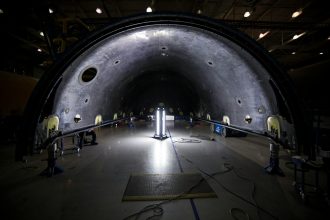zaporizhzhia-nuclear-power-plant
Zaporizhzhia Nuclear Power Plant: Why Power is Critical Now
The stability of the Zaporizhzhia Nuclear Power Plant (ZNPP) remains a paramount global concern. Europe’s largest nuclear facility, situated in a conflict zone, faces unprecedented challenges. Ensuring a consistent power supply to its critical safety systems is not just an operational necessity; it’s a matter of international security. Without reliable external power, the risk of a catastrophic incident escalates dramatically. This article delves into the indispensable role of electricity at ZNPP, recent efforts to secure it, and the broader implications for nuclear safety.
Understanding the Zaporizhzhia Nuclear Power Plant: A Global Concern
The ZNPP, located in Enerhodar, Ukraine, houses six reactors. Its sheer scale makes its operational status a significant factor in regional and global energy security. For years, it supplied a substantial portion of Ukraine’s electricity. However, the ongoing conflict has transformed it into a flashpoint, raising alarms worldwide about nuclear power plant security.
Maintaining the integrity of such a complex facility under duress is a monumental task. The plant’s design, while robust, was never intended for active combat conditions. Therefore, every disruption to its infrastructure, especially power lines, demands immediate attention and international cooperation.
The Lifeline: External Power and ZNPP’s Critical Safety Systems
Why is external power so vital for a nuclear power plant, even when reactors are shut down? The answer lies in the continuous need for essential functions, particularly cooling. Even when reactors are not generating electricity, the nuclear material within them, and in spent fuel pools, continues to produce decay heat. This heat must be constantly removed to prevent overheating, which could lead to a meltdown or other hazardous events.
Uninterrupted power keeps the critical safety systems running. These systems are the plant’s last line of defense against a nuclear accident. Without them, the risk profile of the entire facility changes drastically, moving from manageable to potentially catastrophic. The dependence on a stable power grid highlights the fragility of nuclear safety in conflict zones.
Specific Critical Systems Reliant on Power at the Zaporizhzhia Nuclear Power Plant:
- Reactor cooling systems: Pumps circulate water to remove residual heat from the reactor cores.
- Spent fuel pool cooling: Water in these pools must be continuously cooled to prevent spent fuel rods from overheating.
- Instrumentation and control: Systems that monitor radiation levels, temperature, pressure, and other vital parameters.
- Emergency lighting and communications: Essential for personnel safety and coordination during incidents.
- Ventilation systems: Crucial for maintaining air quality and preventing the buildup of hazardous gases.
Recent Truces and Vital Repair Efforts at the Zaporizhzhia Nuclear Power Plant
The urgency of the situation has prompted localized truces to allow for essential repairs. Damaged power lines, often a casualty of the conflict, must be restored swiftly. These agreements, though temporary, are critical lifelines for the plant. They demonstrate a shared understanding, even amidst hostilities, of the immense danger posed by nuclear instability.
Repair crews face significant risks and logistical challenges. Access to damaged infrastructure can be perilous, and the work itself requires specialized knowledge and equipment. The ongoing efforts underscore the dedication of individuals striving to prevent a wider disaster. These repairs are not just about restoring electricity; they are about maintaining the fundamental safety barrier of the facility.
Steps Involved in Power Line Restoration:
- Damage Assessment: Safely identifying and evaluating the extent of power line damage.
- Security Guarantees: Ensuring the safety of repair personnel through agreed-upon truces.
- Logistical Support: Transporting equipment and materials to the repair sites.
- Technical Execution: Repairing or replacing damaged sections of the power grid.
- System Testing: Verifying the stability and reliability of the restored power lines.
For more information on nuclear safety principles, you can refer to the International Atomic Energy Agency (IAEA) website.
International Oversight and Pathways to Long-Term Stability for ZNPP
The global community, led by organizations like the IAEA, plays a crucial role in monitoring the situation at ZNPP. Their presence provides vital independent verification of the plant’s condition and facilitates diplomatic efforts to secure its safety. The IAEA has consistently called for a demilitarized zone around the plant to ensure its long-term integrity and the safety of its personnel.
Achieving lasting stability requires sustained international dialogue and commitment. The lessons learned from the ZNPP crisis will undoubtedly shape future policies on nuclear facilities in conflict-prone regions. It highlights the interconnectedness of energy, security, and humanitarian concerns on a global scale. Understanding the intricacies of nuclear safety protocols becomes even more critical in such volatile environments.
Further insights into Ukraine’s energy infrastructure challenges can be found on the U.S. Energy Information Administration (EIA) portal.
Conclusion: Safeguarding Our Nuclear Future
The situation at the Zaporizhzhia Nuclear Power Plant serves as a stark reminder of the delicate balance required to maintain nuclear safety, particularly in times of conflict. The consistent supply of power to its critical systems is non-negotiable for preventing a potential disaster. Recent truces and repair efforts, while commendable, underscore the ongoing vulnerability.
The international community must remain vigilant and united in its efforts to ensure the long-term safety and security of ZNPP. Safeguarding this vital energy infrastructure is not just a regional issue; it is a global imperative that affects us all. Stay informed about the critical efforts to maintain nuclear safety and contribute to global energy security by sharing this vital information.
© 2025 thebossmind.com
Zaporizhzhia Nuclear Power Plant power lines repair safety







